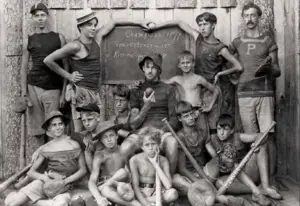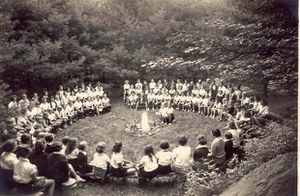What is the history of summer camps in the United States
For children and adolescents, summer camp has been a fixture of American life. In the summer months, parents have often placed their children in summer camps to avoid boredom or even keep them out of trouble. Summer camps can be educational but also fun for those involved, helping to get through the summer months. For adults, it provides a form of childcare as well.
The history of summer camps has in the United States has its origin in the evolution of modern, industrial life in the 19th century that changed the national economy and country.
Early History of Summer Camps
Perhaps the first organized summer camp for children occurred in Gunnery, Connecticut, where Frederick W. Gunn, a well-known abolitionist, established a recreational camp. Already then it was seen as a place where young children can connect with nature. As the Industrial Age progressed after the Civil War in the 1870s, families began to increasingly migrate to cities, escaping country life that also promised fewer opportunities for outdoor activities for families. As adults, often men, worked in factories and sometimes offices, children would often have little to do, in particular during the summer months when there were prolonged breaks from school.
Increasingly, as families began to spend more of their time in the city, they also saw that children would spend a lot of time indoors, where many urban houses or apartments also offered limited outdoor space. This was seen as particularly a problem for boys, where outdoor activities were seen as a way for a boy to develop into a man. Some held that if boys spent a lot of time at home, rather than being outdoors as they would have in the country, they would become more feminized. There was also a fear that boys would grow up to be morally corrupt if they only experienced urban life, leading to religious and community leaders pushing for the establishment of summer camps. This helped to create an initial movement to begin to develop summer camps more substantially across the country, where the first summer camps focused on opportunities for boys to reconnect with the outdoors and the countryside.
Effectively, the earliest summer camps were about escaping the big city and reconnecting with nature so boys can be better men. People saw that being outdoors built character and families began to place their kids, mainly boys, into the relatively few summer camps that established themselves in the 1870s-1880s. Camp Chocorua was an early dedicated summer camp, which was founded in New Hampshire by Ernest Balch, who was a student at Dartmouth college at the time. This camp was seen as a way for boys to heal from potentially negative effects of cities and help develop their character. Boys would get exposed to activities such as swimming, rowing, and even shooting or hunting, with camps also teaching them leadership skills.
Summer camps became not only places for playful activities and sports, but structured education, particularly with moral behavior, was part of the routines. This also meant that many early camps generally catered towards the upper classes as well, as middle and lower classes often could not afford the camps or needed to have their children around to help work in the factories or fields. Educators, philanthropists, health professionals, and religious leaders all soon became major proponents of summer camps, as their interests aligned in seeing summer camps being beneficial not only towards boys but also society more generally (Figure 1). [1]
Related Articles
- The Opening to China Part II: the Second Opium War, the United States, and the Treaty of Tianjin, 1857–1859
- Why did the United States start the Mexican American War
- What Caused The Economic Panic Of 1837
- Why did Andrew Jackson want to destroy the Bank of the United States
- Why did the United States begin directly electing Senators in 1913
- What convinced Americans during the 1918 Flu Pandemic to wear masks
Development of Summer Camps in the 20th Century
There were perhaps no more than 100 summer camps by the end of the 19th century. However, within the first decade of the 20th century, that number expanded to about 1000. By 1910, Alan S. Williams founded the American Camp Association, which began to create certified standards for camps, that included more regimented activities, health standards, and requirements for having a good camp. Children by then would now go for nearly the entire summer, sometimes not returning to their homes until the end of the summer. While many of the early camps focused on the upper class, and increasingly middle-class boys in the early 20th century, by the time of World War I families also began to see that girls also needed to go away to summer camps and that this time could benefit them.
Summer camps for girls began to cater to what parents and society believed would be important life skills for girls, mainly homelife, sewing skills, and preparing for motherhood. Families by the 1920s began to also fear the so-called "Flapper" culture, where women increasingly wore shorter skirts, smoked, and embraced their sexuality. This was also the period of prohibition and increasing crime. These were seen as corrupting activities and many families began to fear the corrupting nature of the surrounding would culture would affect their girls, leading to specialized summer camps for girls that, at least in part, became an anti-cultural movement to the Flappers.
Additionally, marginalized groups, including Native Americans and other ethnic minorities that became established in the United States, also saw summer camps as a way to escape "Americanization" of their cultures and help establish their own cultural and social identities. While today we see summer camps as a distinctive hallmark of American summer culture, by the 1920s and 1930s it was seen as a way to enculturate children from different cultures with their ethnic identities.[2]
Camps were also generally segregated, not only by sex but also by ethnic and racial divides. For African Americans, Camp Atwater became one of the first dedicated camps that focused mostly on middle-class African Americans with recreational, networking, and cultural activities for their children. Religious camps also became more frequent by the 1920s, with Christian and Jewish groups establishing their own camps to educate their children and provide activities during the summer months. Even camps for different political movements, such as socialists, began to be established for summertime activities.
While summer camps were seen as a way to escape the larger culture and help with acculturation of the different sub-groups that composed the United States, one could also argue that summer camps, at least in places, may have helped to divide society rather than help it come together. Nevertheless, for many social groups, summer camps were seen as important for providing cultural and social activities to help their children establish their distinct identity while also engaging in fun activities. Summer camps thus became important to many cultures, and during the Depression years, the New Deal even helped finance summer camps for children to keep them going during the difficult economic times (Figure 1).[3]
What changed summer camps arguably was World War II, where now the horrors of war began to hit home for many families. Childhood began to be seen as a time of innocence, rather than simply to prepare someone for adulthood. Protecting childhood, rather than trying to get out of it, became a theme with summer camps. Increasingly, summer camps began to focus on the arts, playtime, and devoted to activities that many would not do as adults. Summer camps also became more integrated in places, during the war years, as resources were more limited to have too many camps. However, some camps began to see it was important that even children help with the war effort. Children became involved with farming and agricultural activities, such as tending to food gardens, which allowed them to be busy outdoors while also helping with the wider war effort.
By the 1950s and 1960s, summer camps increasingly took their more modern form. Activities that promoted sporting activities, while also encouraging social activity, became common, although specialized summmer camps, such as for Jewish children, continued to also cater their activities that helped acculturate children. For some cultures, it was this period that saw summer camps become a fixture of growing up in the United States. [4]

Recent Trends
Today, summer camps are diverse in the range of activities they provide, including rafting, sailing, archery, and other outdoor activities, as well as cultural and educational events. Camps also cater towards suburban children, who do not venture far from their homes and go only during the day, while others continue the trend of overnight stays, sometimes lasting most of the summer months. Camps are also diverse, with some very specialized with their activities, and perhaps out of reach for many adults' pocketbooks, while others try to blend different children from different socio-economic backgrounds.
With the advent of the Internet and mobile devices, including gaming, many adults see summer camps as a way to escape modern life, similar to how adults saw it in the 19th century. This time, however, it is to escape technologies that makeup daily life and help children better integrate with nature. For educators, it is also seen as a way for children to appreciate nature and better understand threats such as climate and environmental change, with summer camps used also as a way to bring first-hand experiences to what is taught in classrooms. Most of all, summer camps are seen by parents as a fun experience during the summer where children can build life-long friendships and learn skills and hobbies they may not otherwise have opportunities to develop.[5]
Summary
Summer camps have reflected America's changing and different attitudes towards urban life and its views of nature. some views have remained the same, with nature seen as a way to escape modern life. However, attitudes on who can go to summer camp have shifted. Initially, it was only boys, while girls, once they began to go, were relugated to activities that prepared them for motherhood. These attitudes, along with segregation of minorities and cultural groups, now done away with, although some may argue that class and racial divides are still evident in camps, where socio-economic status plays a role in the experience children have during the summer months.
References
- Jump up ↑ For more on the establishment and early summer camps in the 19th century, see: Paris, L., 2010. Children’s nature: the rise of the American summer camp. New York University Press, New York, NY.
- Jump up ↑ For more on the early 20th century and how summer camps expanded, see: Frost, J.L., 2010. A history of children’s play and play environments: toward a contemporary child-saving movement. Routledge, New York.
- Jump up ↑ For more on how summer camps were utilized by different social groups, see: Van Slyck, A.A., 2006. A manufactured wilderness: summer camps and the shaping of American youth, 1890-1960, Architecture, landscape, and American culture series . University of Minnesota Press, Minneapolis.
- Jump up ↑ For more on how summer camps changed at around the time of World War II and later, see: Bond, H.E., Brumberg, J.J., Paris, L., 2006. A paradise for boys and girls”: children’s camps in the Adirondacks, 1st ed. ed. Adirondack Museum/Syracuse University Press, Syracuse, N.Y.
- Jump up ↑ For more on how modern summer camps are catering to today's world and children in America, see: Nadel, M., Scher, S., 2019. Not just play: summer camp and the profession of social work. Oxford University Press, New York.

